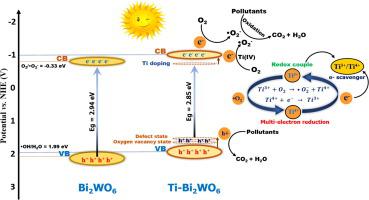Journal of Colloid and Interface Science ( IF 9.9 ) Pub Date : 2020-07-26 , DOI: 10.1016/j.jcis.2020.07.113 Muhammad Arif , Min Zhang , Yue Mao , Qingxia Bu , Amjad Ali , Zhong Qin , Tahir Muhmood , Shahnoor , Xiaoheng Liu , Baojing Zhou , Shen-ming Chen

|
Crystal defects are crucially important in semiconductor photocatalysis. To improve the reactivity of photocatalysts and attain desirable solar energy conversion, crystal defect engineering has gained considerable attention in real catalysts. Herein, we engineered crystal defects and mediate oxygen vacancies in host Bi2WO6 crystal lattice via varying content of Ti dopant to fabricate single-unit-cell layered structure, resulting in enhanced visible-light-driven photocatalytic efficiency. Density functional theory (DFT) calculations verified that the substitution of Bi cation in the crystal structure of Bi2WO6 can induce a new defect level, and increase the density of states (DOS) at the valence band maximum, which not only improve the charge dynamic but also the electronic conductivity. Remarkably, the single-unit-cell layers Ti-doped Bi2WO6 structure casts profoundly improved photocatalytic performance towards ceftriaxone sodium degradation, Cr(VI) reduction, and particularly higher photocatalytic H2 production rate, with a 5.8-fold increase compared to bulk Bi2WO6. Furthermore, the photoelectrochemical measurements unveil that the significantly higher charge migration and charge carrier dynamic counts for the elevated photocatalytic performance. After careful examination of experimental results, it was proved that the Ti doping mediated crystal defects, and engendered oxygen vacancies are critically important for controlling the photocatalytic performance of Bi2WO6.
中文翻译:

钛掺杂对氧空位介导的单晶胞Bi2WO6有改善的光催化性能。
晶体缺陷在半导体光催化中至关重要。为了提高光催化剂的反应性并获得所需的太阳能转化,晶体缺陷工程已经在实际催化剂中引起了相当大的关注。在本文中,我们通过改变Ti掺杂剂的含量来设计晶体缺陷并介导宿主Bi 2 WO 6晶格中的氧空位,以制造单晶单元层状结构,从而提高了可见光驱动的光催化效率。密度泛函理论(DFT)计算证明Bi 2 WO 6晶体结构中Bi阳离子的取代可以诱导新的缺陷水平,并在价带最大处增加态密度(DOS),这不仅改善了电荷动态,而且还改善了电子电导率。值得注意的是,单晶胞层中掺Ti 2 Bi 6 WO 6的结构对头孢曲松钠的降解,Cr(VI)的还原,特别是更高的光催化H 2的产生速率具有显着改善的光催化性能,与之相比增加了5.8倍。散装Bi 2 WO 6。此外,光电化学测量结果表明,显着更高的电荷迁移和电荷载流子动态计数可提高光催化性能。在仔细检查实验结果后,证明了Ti掺杂介导的晶体缺陷和产生的氧空位对于控制Bi 2 WO 6的光催化性能至关重要。



























 京公网安备 11010802027423号
京公网安备 11010802027423号